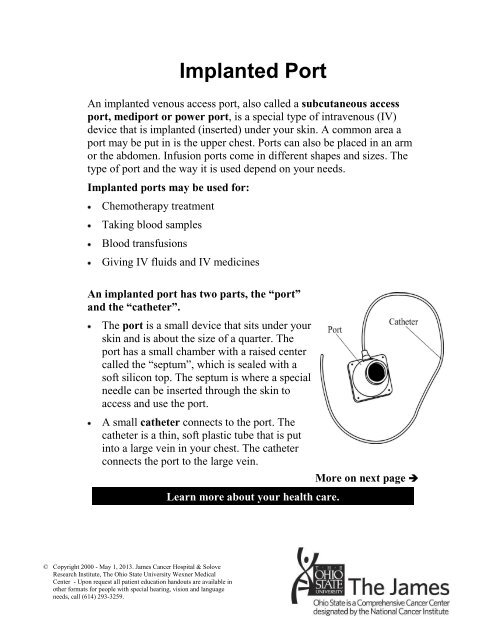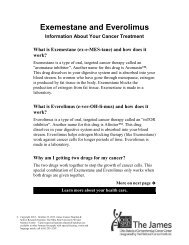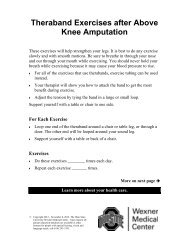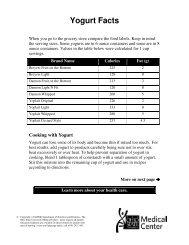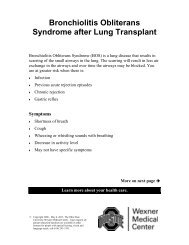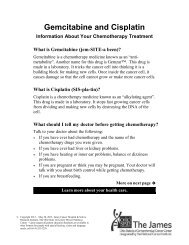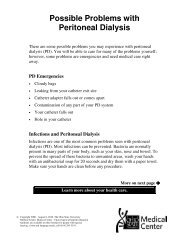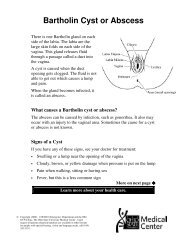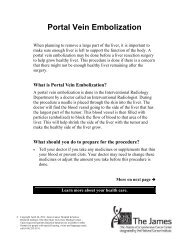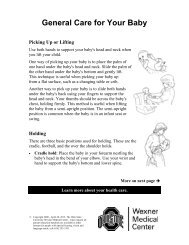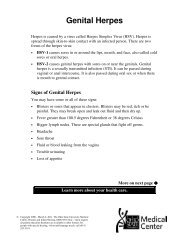Implanted Port - Patient Education Home
Implanted Port - Patient Education Home
Implanted Port - Patient Education Home
Create successful ePaper yourself
Turn your PDF publications into a flip-book with our unique Google optimized e-Paper software.
© Copyright 2000 - May 1, 2013. James Cancer Hospital & Solove<br />
Research Institute, The Ohio State University Wexner Medical<br />
Center - Upon request all patient education handouts are available in<br />
other formats for people with special hearing, vision and language<br />
needs, call (614) 293-3259.<br />
<strong>Implanted</strong> <strong>Port</strong><br />
An implanted venous access port, also called a subcutaneous access<br />
port, mediport or power port, is a special type of intravenous (IV)<br />
device that is implanted (inserted) under your skin. A common area a<br />
port may be put in is the upper chest. <strong>Port</strong>s can also be placed in an arm<br />
or the abdomen. Infusion ports come in different shapes and sizes. The<br />
type of port and the way it is used depend on your needs.<br />
<strong>Implanted</strong> ports may be used for:<br />
Chemotherapy treatment<br />
Taking blood samples<br />
Blood transfusions<br />
Giving IV fluids and IV medicines<br />
An implanted port has two parts, the “port”<br />
and the “catheter”.<br />
The port is a small device that sits under your<br />
skin and is about the size of a quarter. The<br />
port has a small chamber with a raised center<br />
called the “septum”, which is sealed with a<br />
soft silicon top. The septum is where a special<br />
needle can be inserted through the skin to<br />
access and use the port.<br />
A small catheter connects to the port. The<br />
catheter is a thin, soft plastic tube that is put<br />
into a large vein in your chest. The catheter<br />
connects the port to the large vein.<br />
Learn more about your health care.<br />
More on next page
Page 2<br />
How to Prepare for a <strong>Port</strong> Placement<br />
Your doctor will give you information on how to prepare for this<br />
procedure.<br />
Important Medicine Information<br />
Talk to your doctor about any medicines you take to thin your blood or<br />
prevent clots. You may need to change these medicines or adjust the<br />
amount you take before surgery. These medicines include:<br />
Aspirin<br />
Clopidogrel, brand name Plavix<br />
Prasugrel, brand name Effient<br />
Ticagrelor, brand name Brilinta<br />
Ticlopidine, brand name Ticlid<br />
Warfarin, brand name Coumadin<br />
Enoxaparin, brand name Lovenox<br />
Dabigatran, brand name Pradaxa<br />
If you have a stent, do not stop taking your medicines to prevent<br />
clots without first talking to the doctor who put in the stent. For more<br />
information, ask a member of your health care team for the patient<br />
education handout, Protect Your Stent.<br />
If you take aspirin or medicines like aspirin for arthritis pain, your<br />
doctor may have you take a different medicine in the weeks before your<br />
surgery or procedure.<br />
If your surgery or procedure is cancelled for any reason, call your doctor<br />
because you may need to restart the medicines you take to thin your<br />
blood or prevent clots.
How is a port put in?<br />
A port can be put in by a doctor in the operating room or in the<br />
radiology department.<br />
Page 3<br />
An IV line will be placed in your arm and you will be given medicine<br />
to help you relax.<br />
The skin where the port will be put in will be cleaned with an<br />
antibacterial soap.<br />
A numbing medicine will be given to decrease any discomfort. This<br />
medicine will numb the skin on your chest, neck and shoulder.<br />
Two small incisions will be made<br />
during the procedure:<br />
One incision will be made near<br />
the bottom of your neck above<br />
your collarbone.<br />
A second incision will be made<br />
on your upper chest. This is<br />
where the port will be placed<br />
under your skin.<br />
A tunnel is then made under<br />
your skin between the two<br />
incisions. The catheter is<br />
connected to the port, pulled<br />
through the tunnel and placed<br />
into a large vein just above your heart.<br />
The incisions are closed and held together by stitches, special<br />
surgical glue or steri-strips (small tapes). Both incisions are covered<br />
with a small gauze dressing.<br />
You may feel and see a raised area on your chest where the port has<br />
been placed.
Page 4<br />
What to Expect After a <strong>Port</strong> is Put In<br />
You may have some bruising, swelling and tenderness where the port<br />
was put in. These symptoms should go away after 1 to 2 days.<br />
You may have some mild discomfort in the area where the port was<br />
placed. Talk to your doctor about what you can do to help with any<br />
pain or soreness.<br />
How to Care for Your Incisions<br />
Your incisions should heal in about 7 to 10 days.<br />
The nurse will put a check (√) by the information about your<br />
dressing.<br />
You will need to leave the gauze dressing on for:<br />
24 hours after the port is placed, then you may remove the<br />
dressing.<br />
48 hours after the port is placed, then you may remove the<br />
dressing.<br />
Do not remove the steri-strips (small tapes). They will fall off on<br />
their own in about 10 to 14 days.<br />
Keep the incision areas clean, dry and open to the air until they heal.<br />
If you have a small amount of drainage from an incision, put on a<br />
new, sterile 4 x 4 inch gauze dressing. Change the dressing every 24<br />
hours. Leave the dressing off when the drainage stops.<br />
You may shower 1 to 2 days after your port was placed. Follow<br />
the instructions below when you plan to take a shower to keep the<br />
incision areas dry:<br />
Carefully cover both incisions with plastic wrap (Saran Wrap or<br />
Press-n-Seal). If you use Press-N-Seal, be sure to have a gauze<br />
pad over the steri-strip tapes so the Press-n-Seal does not pull the<br />
steri-strips off.<br />
Use tape to seal all around the edges, so water does not get under<br />
the plastic wrap.<br />
After your shower, remove the plastic wrap and gently pat the<br />
incisions dry.
Activity Guidelines After a <strong>Port</strong> is Put In<br />
For about 2 weeks after your port is placed, you will need to hold off<br />
(limit) some activities while your incisions are healing. Here are<br />
precautions you will need to follow.<br />
Page 5<br />
Do not do any strenuous exercises. Do not do activities or exercises<br />
that involve reaching or stretching your chest and neck areas.<br />
Do not lift anything heavier than 10 pounds (a gallon of milk is about<br />
8lbs).<br />
Talk to your doctor or nurse about when you can return to your<br />
normal activities.<br />
Note: Do not play contact sports while you have a port.<br />
Care and Use of Your <strong>Port</strong><br />
A port can stay in place as long as you need it and it is working well.<br />
This can be for several months to a year or longer.<br />
After your procedure, you will get a manufacturers patient<br />
identification card. This card gives details on the type of port that was<br />
put in. Keep this card with you at all times. Bring it with you to your<br />
treatments and doctor visits so your health care team knows you have<br />
a port.<br />
Your port should be flushed with a fluid<br />
after each time it is used. If your port is<br />
not being used, it needs to be flushed<br />
every four weeks. This keeps it clear<br />
and open. If you have more than one<br />
port opening, each one should be<br />
flushed.<br />
Sterile Technique should always be used<br />
when your port is accessed.<br />
When your port is accessed a special<br />
non-coring needle called a Huber Needle will be inserted. This type<br />
of needle has a 90-degree angle (see picture). Do not let anyone use<br />
any other type of needle in your port.
Page 6<br />
If you have a special type of port, such as a power port, tell your<br />
nurse before they access and use the port. A power port may be used<br />
for special radiology contrast dye injections during radiology tests<br />
such as a CT scan. A power port requires a special type of needle to<br />
be used when accessing the port.<br />
Call your doctor right away if you have any of the<br />
following:<br />
Shortness of breath<br />
Dizziness<br />
Increased bleeding or drainage from your incisions<br />
Fever of 100.4 degrees Fahrenheit (38 degrees Celsius) or higher<br />
More redness at your incision<br />
Increased pain, bruising, tenderness on the same side the port was<br />
placed<br />
Swelling of the face, neck, chest or arm on the same side where the<br />
port was put in<br />
Any other problems with your port<br />
Talk to your doctor or others on your health care team if you<br />
have questions. You may request more written information from<br />
the Library for Health Information at (614) 293-3707 or email:<br />
health-info@osu.edu.


